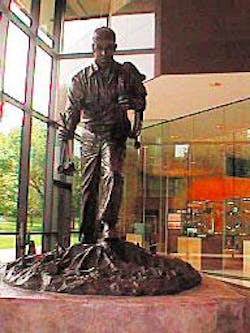The Doodlebugger
Many organizations have long sought ways to commemorate their pasts while emphasizing to new generations the importance of work still to come. Symbols are needed to mark important events. That's why there are statues in parks of generals on horseback waving flags or swords.
An industry too needs these symbols to mark its past and point to its future.
The Society of Exploration Geophysicists (SEG) has found such an icon in "The Doodlebugger." The Doodlebugger is a statue created by sculptor Jay O'Melia, and it resides now in the atrium of SEG's headquarters in Tulsa. The statue, unveiled in a ceremony May 2, stands nearly 10 ft high (including the base) and weighs more than 600 lb. O'Melia, by the way, created the "Oil Patch Warrior" that stands now in England's famous Sherwood Forest. That 7-ft bronze statue commemorates American workers who drilled for and produced oil secretly in those woods during World War II.
Doodlebugger has become a generic name for a seismic field worker. The term originated at least as far back as the 1930s and referred to unconventional methods of exploration. A "water witch" with a forked limb was sometimes referred to as a "doodlebugger."
Today, we see the doodlebugger as the point where all exploration work begins, and so this statue represents the foundation of geophysical exploration.
Dedication
This editor attended the unveiling of the statue to see how the artist would interpret someone on a seismic crew. (While in college 40 years ago, I had worked on such a crew as a "jug-hustler" in the marshes of South Louisiana.) Working my way through the crowd, I found The Doodlebugger sitting atop its stand in the atrium, covered with a large black drape and surrounded by expectant SEG members and guests.
Even though it was still covered, however, it looked natural. I hadn't seen the statue yet, but I instantly appreciated the artistic touch of covering it with a black drape representing the ever-present cloud of mosquitoes and gnats in the Louisiana swamps. That's something you don't forget, even after 40 years.
SEG Foundation
The statue stands just outside the SEG Foundation's museum in the Geosciences Center. The museum's displays are built around various pieces of geophysical equipment donated by friends and members of SEG. Some of the items on display include:
- The original notebooks from about 1923 and other items belonging to John Karcher, inventor of modern reflection seismic prospecting.
- Ludger Mintrop's mechanical seismograph of 1922, on loan from the Smithsonian, which is said to have made the discovery of the Orange salt dome on the Texas Gulf Coast.
- A seismometer built for Admiral Byrd for his second Antarctic expedition, 1933-35. It was operated by Charles Gill Morgan to measure thickness of ice.
Many of the displays are interactive. That is important because the museum has become an impressive center for geoscience education.
Education
Geoscience education is being emphasized at all levels by SEG. There are 1-2 day continuing education courses for members held at various times of the year. Companies may also contract for SEG instructors to teach on site wherever they are needed. There are 32 courses currently being offered under six headings: seismic data acquisition; seismic data processing; seismic data interpretation; potential field, nonseismic; near-surface geophysics; and exploration and production geophysics.
Courses can be specially tailored for audiences whose backgrounds are unrelated to geology or geophysics, such as accountants and engineers.
Programs are presented to various tour groups at the Geosciences Center and museum. These tour groups include business college classes, retirees, Boy Scouts, and day care centers. Presentations are not canned, but geared to fit the audience.
A traveling museum goes out to schools and conventions-any place the message needs to be taken. SEG's goal is to "teach the teachers," and workshops are occasionally presented to do just that.

